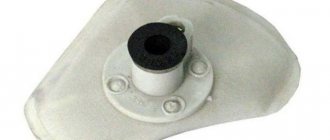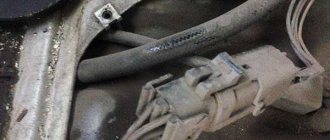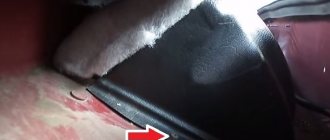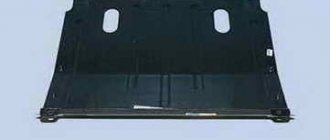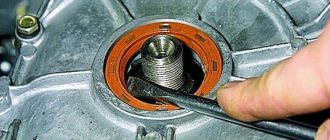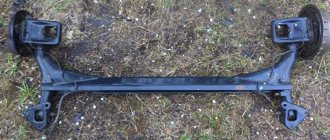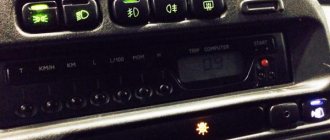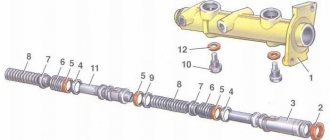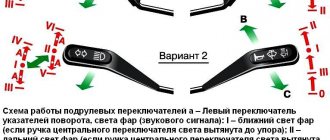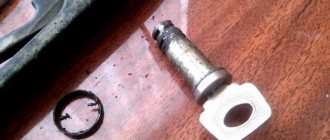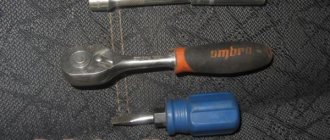The fuel filter in cars is a vital element of the fuel system, which filters small particles of rust and dust, and also prevents them from entering the fuel system line. In the absence of a filter and with a small flow area in the fuel line, dust and rust particles clog the system, preventing fuel supply to the engine.
The filter system is divided into two filtration stages. The main and first stage of fuel purification is coarse cleaning, which removes large particles of dirt from the fuel. The second stage of cleaning is fine fuel cleaning; this filter installed between the fuel tank and the engine allows you to remove small particles of dirt.
Symptoms of a clogged fuel filter
To protect the injectors and piston group from contamination and corrosion, it is necessary to thoroughly clean the incoming fuel from foreign particles, moisture and resins. This function is performed by a filter element that is installed between the tank and the pump.
The most common signs of a clogged fuel filter are high fuel consumption and reduced engine power, so the layer must be changed regularly.
Causes of a clogged fuel filter
The reasons for filter contamination are:
- low quality gasoline or diesel fuel;
- penetration of water into the tank with subsequent formation of ice crystals at low ambient temperatures;
- surface corrosion with release of metal particles and oxides;
- accumulation of resins and foreign impurities from oil and additives;
- accumulation of dirt and bottom sediments in the fuel tank;
- very dusty air, frequent off-road trips.
Self-diagnosis
Filter diagnostics include assessing engine performance during operation, measuring fuel pressure and visual inspection. Measurements are taken through the ramp fitting, which distributes fuel to the injectors.
- hose with internal diameter 9 mm;
- fastening clamp;
- a device for determining gasoline pressure or a pressure gauge with a value range of 7-10 bar.
A special device can be purchased at a car store. The pressure gauge is connected to the hose and tightened securely with a clamp. To ensure the tightness of the contact, sanitary flax is used. The hose is connected to the fuel pressure fitting, after first removing the plug from it and removing the nipple.
After this, measurements are taken in various engine operating modes (at idle, after starting, with the drain tube pinched). The indicator after turning on the ignition should be at least 3.8-4 bar.
After the measurement, you need to turn off the engine and wait 20-30 minutes for the regulator to gradually reduce the pressure in the ramp. After this, disconnect the pressure gauge and reinstall the nipple and plug.
The first symptoms of a dirty fuel filter depending on the engine type
The degree of influence of the filter on engine operation depends on its type. Carburetor gasoline engines practically do not react to contamination of the cleaning layer. Minor changes can only be observed in the power and stability of the internal combustion engine.
The injector is more demanding on the pressure in the fuel line, so a decrease in filter capacity is immediately manifested by a drop in engine power. The most obvious symptom becomes at high speeds.
Motors that run on diesel fuel are the most sensitive to foreign particles and impurities. Their power and stability of operation directly depend on the level of pressure in the fuel line. When it decreases, startup delays and sudden jerks while driving are observed. In some cases, the engine turns on only after several attempts.
The sensitivity of engines to pollution is largely due to their requirements for the degree of fuel purification. Filter elements for diesel engines should not allow particles larger than 4-5 microns to pass through, for injection engines - 10 microns, and for carburetor engines - 20 microns.
User Experience
My engine rarely stalls. A couple of times there were simply problems with the fuel, but once there was a problem with the pump. I figured out how to take it apart myself. I realized that there was no damage, it was just pollution. I had to change the grille - before I had no idea that they could be cleaned. Since then I have driven a hundred thousand kilometers and so far everything is fine. When another 20-30 thousand are added, then I’ll look under the hood. This time only for preventive purposes.
I'm new to driving, but have already encountered this procedure. When the car didn't want to start the first time, I thought the problem was with the battery. But then the engine began to behave strangely - it either would not start or suddenly increased speed. Friends suggested that we need to disassemble and clean the pump. As it turns out, it's not difficult at all.
I became a motorist five years ago. Since then, I have never needed to repair or change anything - my husband usually does this. He simply cleans the grille for himself, but always installs a new one for me. The answer to my questions is that it is safer.
I clean the grille every 150 thousand kilometers traveled. I have a sedan made by Nissan, and I almost never drive it outside the city. Although there are no particular problems, I should do this after about a hundred kilometers. Focus on the ignition - if everything is fine with the battery, then the pump is probably dirty.
I never do this myself and I don’t recommend it. Any car service center will do this procedure almost free of charge. In addition, mechanics spend less than half an hour on it, and when you do it yourself, you don’t know exactly how much more digging you’ll have to do.
On a car like Lanos, replacing the fuel pump grid is not particularly difficult. Therefore, if the time has come to replace this part on your car or characteristic symptoms of a clogged mesh appear, then you can safely get to work. The work will take about two hours at a leisurely pace.
Lanos: replacing the fuel pump mesh is done in a garage, you don’t need to go to a service station for such a simple job, you don’t need rare tools either. Before describing the replacement process, it is worth saying that the fuel pump mesh is located in the gas tank, specifically in the fuel pump glass. The purpose of the mesh is to filter the incoming gasoline into the fuel pump, and, consequently, into the engine. It traps debris and other dirt that somehow got into the gas tank.
Replacing the mesh on the fuel pump is recommended every 30 thousand km. But, if you give statistics, then one part of car owners changes it almost every 10 thousand km, while another, no less, part drives 50 thousand or more, without replacement. Then a logical question arises: when should it be changed?
The main signs of a clogged fuel pump filter
The main signs of a clogged layer in front of the pump are a decrease in vehicle power, loss of control stability and increased failures when starting the engine. In the initial stages, these symptoms only appear under certain conditions (such as driving uphill, accelerating, or idling), but over time the problem begins to worsen.
Reduced engine power
A decrease in engine power when the filter is dirty is due to the fact that the fuel pump and cylinder do not receive enough fuel. In this case, under increased load, the engine begins to turn off and stall. Sometimes the power of the power unit is not even enough to start.
The engine runs rough at idle
A decrease in pressure in the supply system may be accompanied by uneven idling, spontaneous shutdown and delayed re-ignition of the engine.
Violation of the functional stability of the engine is caused by a poor air-fuel mixture.
Increased fuel consumption
When starting with clogged filters, the internal combustion engine and pump experience increased load, and the composition of the fuel-air mixture deviates greatly from the optimal one. This affects fuel consumption and the wear rate of parts.
The nuances of replacing the fuel filter with your own hands
To replace the filter you will need a set of wrenches, a screwdriver, a fuel container, a pump and gloves. The location of the elements depends on the model and type of engine. For example, to repair the system on a car with an injection engine, it is often necessary to remove the rear seat, disconnect the hoses through a special hatch, remove the pump connector and dismantle part of the fuel line.
Disposable filter elements are replaced entirely, and sedimentation tanks and meshes for rough cleaning are thoroughly washed with clean fuel.
It is better to replace it in the fall or in preparation for the cold season. This will facilitate the passage of thickened fuel to the pump.
To extend the life of the filter, you must:
- refuel at trusted stations;
- do not fill the fuel supply into rusty and dirty cans;
- avoid refueling immediately after filling the gas station from the tank;
- wash the tank at least 1-2 times a year, regularly clean the coarse filter and drain the sump;
- When driving a diesel car, switch to winter fuel in a timely manner.
Before a long trip, it is advisable to include a fine filter in the list of spare parts that you need to take with you.
Regularity
Car manufacturers recommend changing fuel filters every 15-30 thousand km on diesel engines and 40-100 thousand km on gasoline engines. If signs of clogging appear earlier, then unscheduled maintenance needs to be carried out. Depending on the driving conditions, condition and type of engine, the recommended replacement frequency can be reduced to 1 time every 10-15 thousand km.
Source of the article: https://gdetoplivo.ru/toplivo/simptomy-zabitogo-toplivnogo-filtra
Types and categories of filters
Depending on the fuel system, a fine filter is selected due to the fact that each filter for each fuel system is different in design. Therefore, we have three types of filters depending on the fuel supply system:
- Carburetor;
- Injection;
- Diesel.
Filters are also divided into two categories: main filters (they are located in the fuel line itself (for example: a mesh in the tank), as well as submersible ones - they are installed in the tank in conjunction with a pump. The coarse fuel filter is a mesh filter, as well as reflector, the mesh consists of brass and does not allow particles larger than 0.1 mm to enter. Thus, this filter removes large impurities from the fuel. And the filter element itself is located in a glass, which is secured using a small ring and a pair of bolts. A paronite gasket closes the gap between glass and body. And at the bottom of the glass there is a special damper.
Thus, the filter cleans itself before gasoline enters the fuel system. The fuel filter also uses an injection reduction valve, which regulates the operating pressure in the fuel system; all this is installed in addition to the direct injection system. And excess fuel can be returned to the fuel tank. In a diesel system, the filter is functionally used in the same way, but necessarily has a different design.
If you are replacing the fuel filter yourself, you must first decide on the location of the filter. Typically it will be located:
- Under the bottom of the car;
- In the fuel tank (mesh in the tank);
- Engine compartment.
The fuel filter can be easily changed without the help of professionals, but if you doubt your capabilities, you can ask for advice from more experienced car enthusiasts or ask specialists. Experts also point out that the fuel filter needs to be changed every 25,000 km. But it also depends on the fuel you use; if the fuel is of poor quality, then it is recommended to perform this action more often.
Cleaning the fuel pump mesh yourself
Cleaning the fuel pump is a fairly urgent procedure that must be carried out when the following symptoms appear:
- Difficulty starting the engine with the starter;
- reduction in vehicle acceleration dynamics;
- jerking when pressing the gas pedal sharply;
- floating speed and sluggish engine response;
- the engine stalls in transition modes after pressing the accelerator, etc.
In some cases, when you press the gas, the car practically does not accelerate, overcomes inclines with great difficulty, and does not overtake. There may be several reasons for such a malfunction, but often the problem is localized in the fuel pump area. Next, we will consider issues related to the electric fuel pump, which is installed in the gas tank of injection cars.
Fuel coarse mesh in the fuel pump - why is it needed?
The initial cleaning of the fuel is ensured by a mesh mounted on the fuel pump body, and when the car begins to move jerkily and the fuel supply is difficult, first of all you should check the condition of this mesh, because it can be contaminated to such an extent that its initially snow-white color is very difficult to recognize.
Note! The main reason for grid contamination is poor fuel quality!
When to change the screen in the fuel pump?
In order to understand when it is necessary to replace a particular component in the fuel system, and specifically the grid, you need to know about the presence of pressure in the fuel rail. You can learn how to take measurements correctly from this article.
You can also find out about its insignificant condition by the following signs:
- a very prolonged and loud hum occurs , since gasoline is hardly sucked into the system through a clogged mesh. This can significantly reduce the working life of the fuel pump itself and the contamination of the entire fuel system as a whole.
- While driving, when switching to third or fourth gear and then pressing the gas pedal, there is no increase in power .
- Also, a clogged mesh can cause a loss of speed while the car is moving , since the required amount of fuel simply does not enter the combustion chambers.
When and why you need to change/clean the fuel pump screen
Let's start with the fact that general problems with the fuel system (fuel pump in particular) should be divided into the most common groups:
- the fuel pump mesh and fuel filter are clogged;
- the fuel pump itself has failed;
- injector problems;
Let us add that we should also not exclude the possibility of air leaks, that is, airing of the power system. Another culprit of problems may be the pressure regulator in the fuel rail. In this case, engine malfunctions may be partially similar to some of the symptoms mentioned above. For example, a slight ingress of air into the fuel system results in the engine not starting for a long time after parking.
Let's go back to the fuel pump. Its malfunction means that the performance of the fuel supply system is reduced. If the fuel pump breaks down, then the car becomes unsuitable for normal use. Signs of a fuel pump malfunction are as follows:
- It is impossible to start the engine, the fuel pump does not pump;
- the engine starts, but runs with serious interruptions;
In this case, the service often recommends diagnosing, repairing or replacing the fuel pump. It should also be taken into account that the fuel pump mesh filter may become clogged inside the device. Let us immediately note that it is impossible to accurately answer the question of when to clean the fuel pump stack. Some car enthusiasts clean/replace the fuel pump mesh as needed or as a preventative measure every 50-70 thousand km. mileage, while others are faced with the need to clean the fuel pump grid for the first time at mileages of 150 thousand km or more. and more. Let us add that the operating manual for some models specifically states that it is recommended to replace the fuel pump stack once every 120 thousand km.
It should be added that the loss of dynamics and the appearance of symptoms of a clogged mesh occurs gradually. For this reason, each driver decides to clean the fuel pump himself. On powerful naturally aspirated engines, the gradual deterioration in acceleration is not felt as strongly as compared to highly accelerated engines with a small displacement. For this reason, many owners of large-volume trucks begin to solve the problem after noticeable complications appear. Also, the condition of the pump grid is greatly influenced by the quality of the fuel being filled and a number of other factors and individual operating conditions, which we will talk about a little later.
Fault diagnosis
There are several signs that indicate that the fuel pump is clogged. Each of them individually may not indicate this one hundred percent, but taken together they are sufficient grounds to begin cleaning. These are the signs:
- the engine stalls when you press the accelerator;
- the acceleration dynamics of the car decreases;
- the engine responds poorly;
- starting with the starter is somewhat difficult;
- When the gas pedal is pressed sharply, jerking occurs.
Depending on how badly the fuel pump is clogged, these problems can vary greatly in scope. For example, if the pollution is very high, then when you press the gas pedal, the car may hardly accelerate.
Cleaning the fuel pump screen can solve these problems, but it is important to remember that there are other reasons that can cause them:
- The injector has failed.
- The fuel pump is not working correctly.
- The fuel filter is dirty.
If the filter and mesh are still easy to change on your own, then for the rest it would be better for a beginner to contact a car service center. This will allow you to avoid gross mistakes that an inexperienced car enthusiast may make during the repair process.
How to clean the fuel pump yourself
Let's start with the fact that the mesh filter for the fuel pump is a coarse filter and is designed to capture large particles and deposits that are in the fuel and inevitably accumulate in the fuel tank. It turns out that the fuel pump has its own additional fuel filter mesh, which prevents debris from entering the fuel system from the tank parallel to the usual fuel filter. The process of cleaning or replacing the fuel pump mesh is almost similar to the general scheme for replacing the pump itself:
- The fuel pump is installed directly into the gas tank. You can get to the pump from the passenger compartment, as it is located under the rear seat. To gain access to the fuel pump, you need to remove the rear seat cushion or fold down half of the sofa (if possible).
- The fuel pump is usually located on the right and covered with a special plastic cover. The specified cover must be removed.
- Before removing the fuel pump itself, it is necessary to relieve the fuel pressure in the system. To do this, you will need to disconnect the power connector from the fuel pump, and then turn the engine with the starter.
- The next step is to remove the negative terminal from the battery, after which the tubes from the fuel pump are disconnected. These tubes are “supply” and “return”, they are secured with clamps that need to be pressed out.
- Next, you need to unscrew the special pressure ring-cover of the fuel pump. It is very difficult to unscrew this cover manually. There is a special fuel pump cover puller for removal. If there is no such puller, then you can try to carefully unscrew the ring using improvised means. We strongly recommend that you first study on specialized auto forums how to remove the fuel pump cap on a specific car model.
- After unscrewing the cap, you can remove the fuel pump. Before complete removal, the remaining gasoline should be drained from its body, and the sealing ring should be removed.
- Now you can begin disassembling the fuel pump housing. To clean, you will need to remove the bottom part. There is often dirt in the indicated lower part of the housing.
- After this, remove the fuel pump screen. To remove the mesh, just pry out the filter at the place of attachment to the pump body using a regular screwdriver. The fuel pump strainer usually becomes completely clogged, especially on cars with high mileage.
- Then the fuel pump mesh can be replaced with a new one or cleaned. It is better to wash the fuel pump mesh first with carburetor cleaner. Mechanical cleaning is done with a soft brush. Then the mesh should be dried and blown. The bottom of the pump housing and the cleaned mesh are finally washed again with gasoline.
- The final step is to reassemble the fuel pump and install the device in the gas tank. To facilitate installation, it is better to invite an assistant, as it may be necessary to ensure high-quality pressure of the pump to the tank. The fact is that many gasoline pumps have a special spring, the force of which must be overcome. At the same time, you need to make sure that the rubber seal is in place and at the same time screw in the pressure ring-cover of the fuel pump. When tightening the clamping ring with a puller or improvised means, do not exceed the tightening torque. If you tighten it too tightly, the fuel pump cap may burst; if you tighten it too weakly, the fuel pump will wobble due to poor fixation.
Replacing the filter
Toyota Yaris fuel filter location
Due to the fact that the filters are different in design, the algorithm for replacing them will be different. However, for the sake of example, the car chosen was the Toyota Yaris. First of all, we reduce the pressure in the system. To perform this action, we will remove the fuel pump fuse, which is located near the gear knob. This procedure turned off the pump and we can now start the engine. After waiting 1-2 minutes, the engine will stall, which will be a clear sign of a drop in pressure in the fuel system. Now let's move on to the right wheel, where the filter itself is located. It is located on the right, not far from the fuel tank. Press the latches to release the pump. We take out the old filter. Be careful when installing, the arrow on the filter should go in the direction of the fuel flow. We return the fuel fuse and, if necessary, “light” the car. Due to an imbalance of pressure in the fuel system, the car will not start the first time; you need to wait some time until the pressure in the system stabilizes.
Let's take note that older cars did not have a filter and the car owner had to connect it himself.
The standard case is when this was done through a cut in the suction line, directly in front of the fuel pump. It is worth taking into account that there are modern models without a filter, and those equipped with injection do not have pumps. As an example, Ford Focus and Mondeo were without filters from the very start, and in Renault Logan this unit was excluded about five years ago. If you wish, you can retrofit the system yourself, but in modern models this does not matter: it has been empirically proven that the mesh wears out approximately simultaneously with the pump itself. In this option, the unit has to be changed completely, which in itself is expensive, and also quite complex and painstaking, since the pump is usually located in an inconvenient place, and there is no service hatch. While there are models without a filter, models may also have different filter locations. The filter can be remote; or use a replaceable cartridge, which is located directly in the fuel pump. Easily removable tips are the connecting element of the fuel line. In order to remove them, you need to use pliers.
